🚀 CloudSEK has raised $19M Series B1 Round – Powering the Future of Predictive Cybersecurity
Read more



.jpg)
In July 2025, one of CloudSEK’s premier banking clients had reached out, requesting assistance to investigate a wave of social media content, depicting the rise of a new “finfluencer” named Shewta Sharma. The suspicious nature of Shweta’s guarantees of unrealistic returns from the stock market, aided by an upfront payment, is concerning.
Shwetha was merely a figure impersonating a popular beauty influencer. Scammers utilized deepfake content to drive engagement to their Telegram channels, withholding the invested money under the guise of stuck payments. They further request more payments to free up the principal amount, leading to a never-ending cycle. Almost 120 actively running ads were found from various accounts.
With the number of complaints on the outlet “Consumer Complaints Court” racking up against the bogus finfluencer, including grievances regarding non-payment of money citing various excuses, it creates a cause of concern amongst the general public. This feeds into the FOMO of not investing in the stock market and racking up unrealized returns with unrealistic expectations.
This report will be providing insights into the wave of content that is aiming to dupe people, helping banks to conduct awareness drives aimed at customers to distrust unreliable finfluencers without any solid background or credentials to back them at handling customers’ hard-earned money.

Note: Relevant pages tied to this scam operation have been mentioned in the Appendix section of this advisory
Drawing parallels with pig-butchering scams that are aided by deepfake videos of your favorite celebrity, urging the common public to chase a once in a lifetime opportunity, this blind chase is fueling a surge in scams like rug pulls, where investors pour money into fraudulent schemes and promises (often without any credible evidence to back it’s legitimacy) only to watch their funds vanish overnight.
Here, we have a wave of deepfake content that’s used by scammers to convince the general public. The narrative is to invest in the stock market, with a nominal investment being required, and a standing claim that the money would be doubled in 2 or 3 hours, via trading on the stock market.
With those rates of returns standing no ground in a neutral sense, people are still feeding into the FOMO of not investing in the stock market, and not forgoing the chance to rack up unrealized returns. These funds then go to the scammers’ pockets, with hopeful people left in the lurch on the initial amount being returned to them.
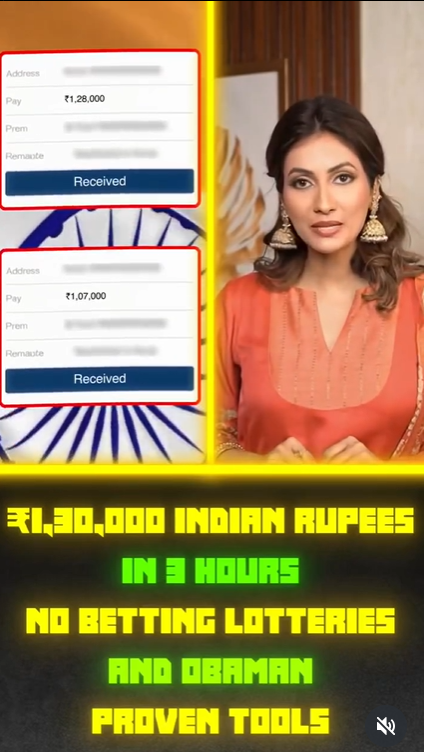
These carry a similarity to penny stocks being peddled through promotions, via SMS, leading to an eventual pump-and-dump scenario.
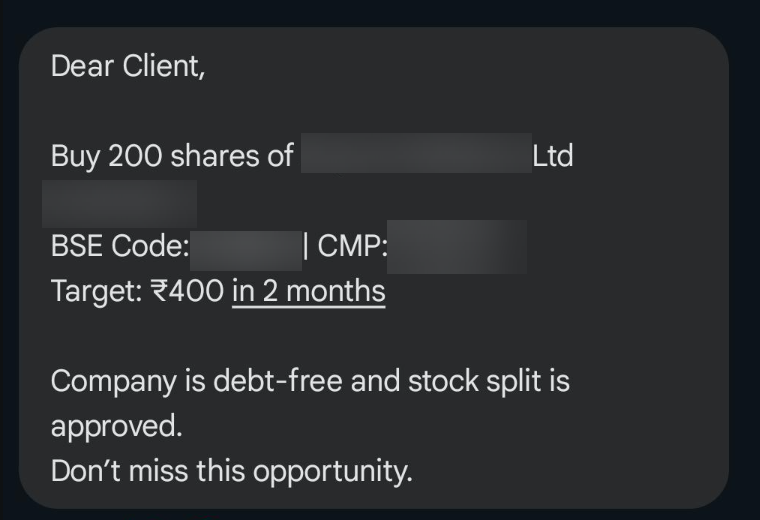
The finfluncer’s content started gaining traction around May 2025, with social media outlets like Instagram and Facebook being utilized to run ads. Screenshots of instant payments made via UPI to investors also helped to drive traffic. From a neutral point of view, the screenshots indicate transfer of amounts within the scammer’s accounts and then driving a narrative - using testimonials.

Here are some of our observations:-
Usage of Deepfakes:
The finfluencer has been utilizing deepfakes to land attention to her investment strategies. Allying herself with banks to appear legitimate, and using these brands to back her credentials. An example is that of using a multinational public-sector bank’s advertisement and it’s brand ambassadors to promote her investment strategy.

Another deepfake instance is that of using a private bank’s advertisement media, and utilizing it to promote the scammer’s investment strategies.


Findings:-
Active Impersonation Attempts:
During our investigation process, it was found that the severity of the case goes deeper. Videos of Shweta Sharma in circulation are in fact, those of “Prerna Nigam”, a lifestyle influencer, more notably known as the runner up of the Mrs. Femina 2021 Beauty Pageant
This discovery established the fact that a group of scamsters are behind this orchestrated operation to swindle money, rather than having a real finfluencer to be the face of this scam operation.
Most of the content that is circulated on the scamsters’ various profiles were lifted from Prerna’s Instagram account.

During our dive into Shweta’s multitude of ads across social media, domains used to promote them and from performing a reverse IP on them, domain names containing the names of other bogus finfluencers could be discovered


A notable example is that of a bogus finfluencer named “Elena Fernandez”. In this case, the identity and photos of Tjin Lee, a Fashion Content Creator was embossed over posts, in the guise of offering investment advice.
Tjin Lee had addressed the confusion amongst potential victims on Facebook
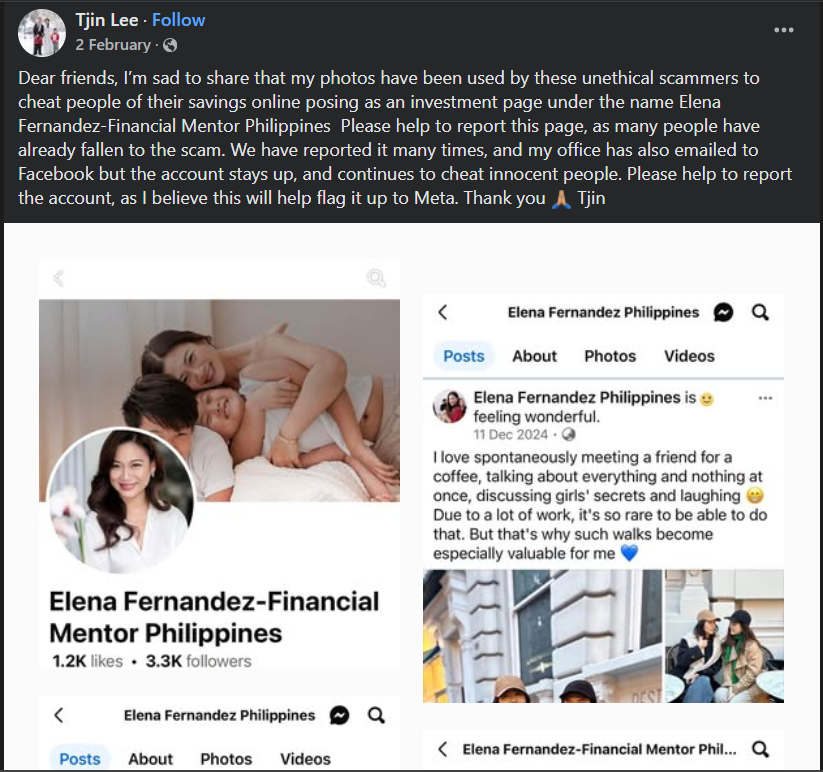
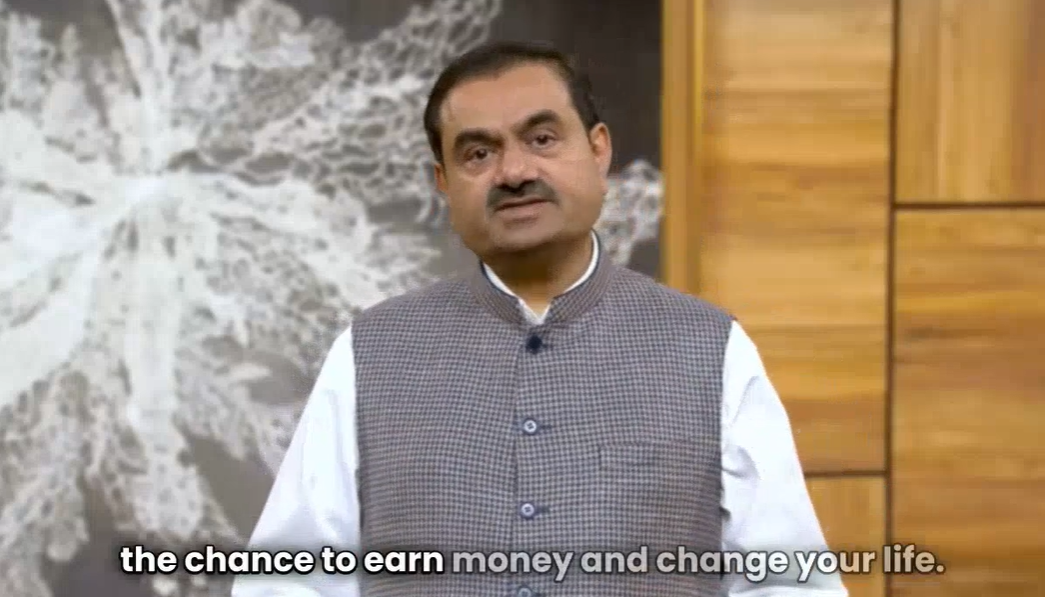
The screenshot of the video showcased above is not real.
The face, the voice, the seemingly authentic endorsement - all generated or manipulated using AI. Yet, it convincingly presents itself as a genuine financial tip from a trusted public figure.
This is the new face of fraud, where trust sells to lure and trap people
Since mid 2023, a growing number of campaigns have begun weaponizing deepfake technology to impersonate influential business leaders, celebrities, and financial experts, on Indians’ social media feeds. Their goal: to convince unsuspecting users to invest money in fraudulent crypto platforms, “quantum trading apps,” or traps labelled as pig butchering
But while the technology used is sophisticated, the real story lies in the scale of the operation - and the platforms that enable it.
Using a combination of open-source data, and Meta’s Ad Library data, we found:
Ads featuring impersonations of personalities such as Mukesh Ambani, Ratan Tata, and even local Indian startup founders, with only minor voice/dialect adjustments for regional targeting.

Other statistics:
Meta relies mainly on automated classifiers to scan every ad for policy violations. Only if an ad is flagged (or after many reports) will it be manually pulled. The company has even begun testing facial‐recognition tools to catch “celeb‐bait” ads that use an image of a public figure
But savvy scammers use non-celeb actors or AI voices to slip through these filters.

Meta’s ad platform is designed for broad reach with small spend. Impressions (the count of times an ad is shown) can snowball quickly. In marketing terms, “impressions” count every time an ad appears on a user’s screen (even repeats by the same person)
By contrast, “reach” is unique users. So if one user sees a scam ad 3 times, that’s 3 impressions. Meta’s Ad Library actually provides impression counts in rough ranges (e.g. 1,000–5,000 views) for archived ads Researchers using the library have found that modest budgets yield large exposure. For instance, one fake-investment page spent ≈US$500 and earned ~10,000 impressions in just a few days

Utilization of gclnk.com links. These redirect users to Telegram Channels endorsed by scammers. These are embedded within the Profile Intro section of a Facebook Page


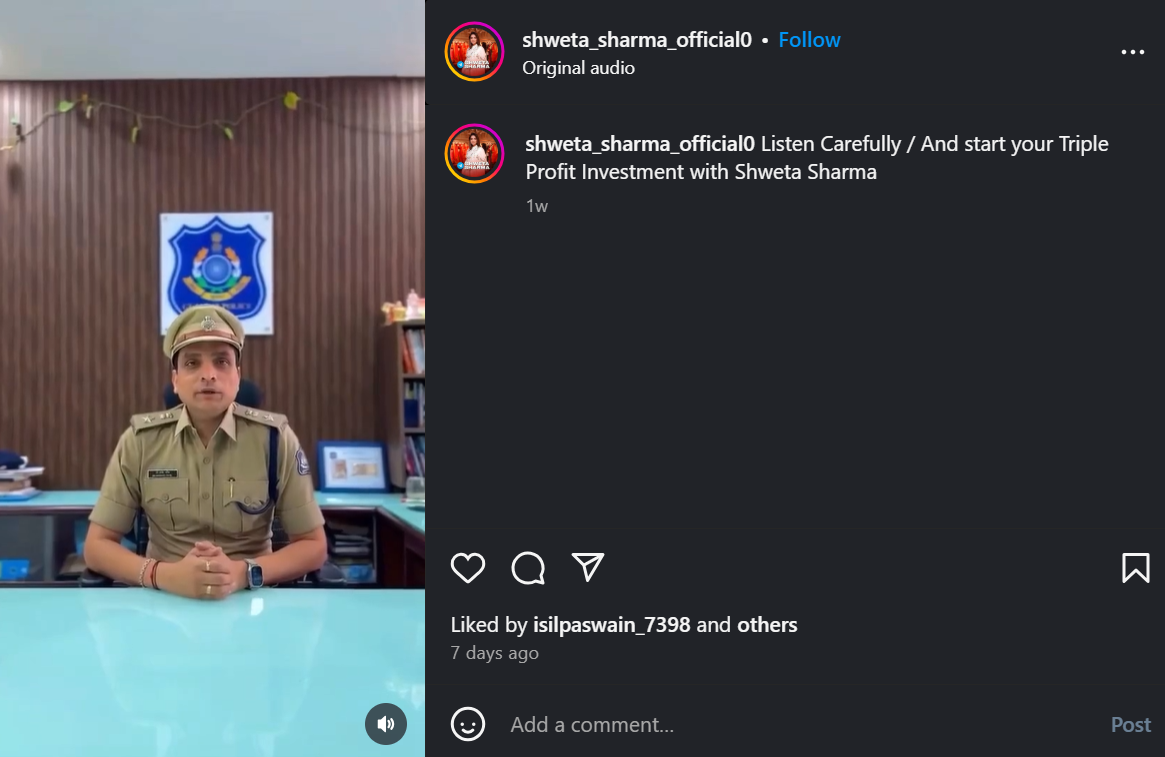
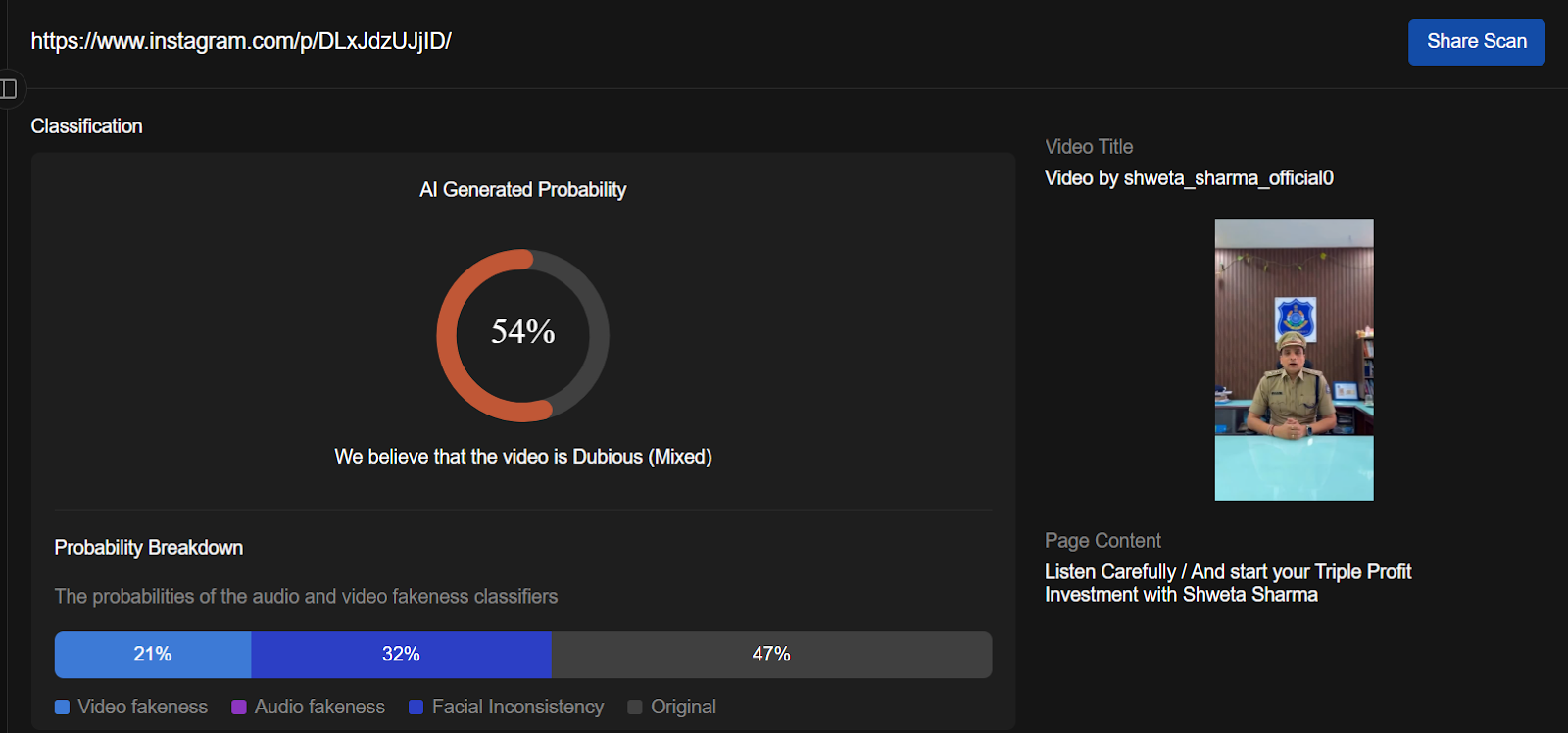

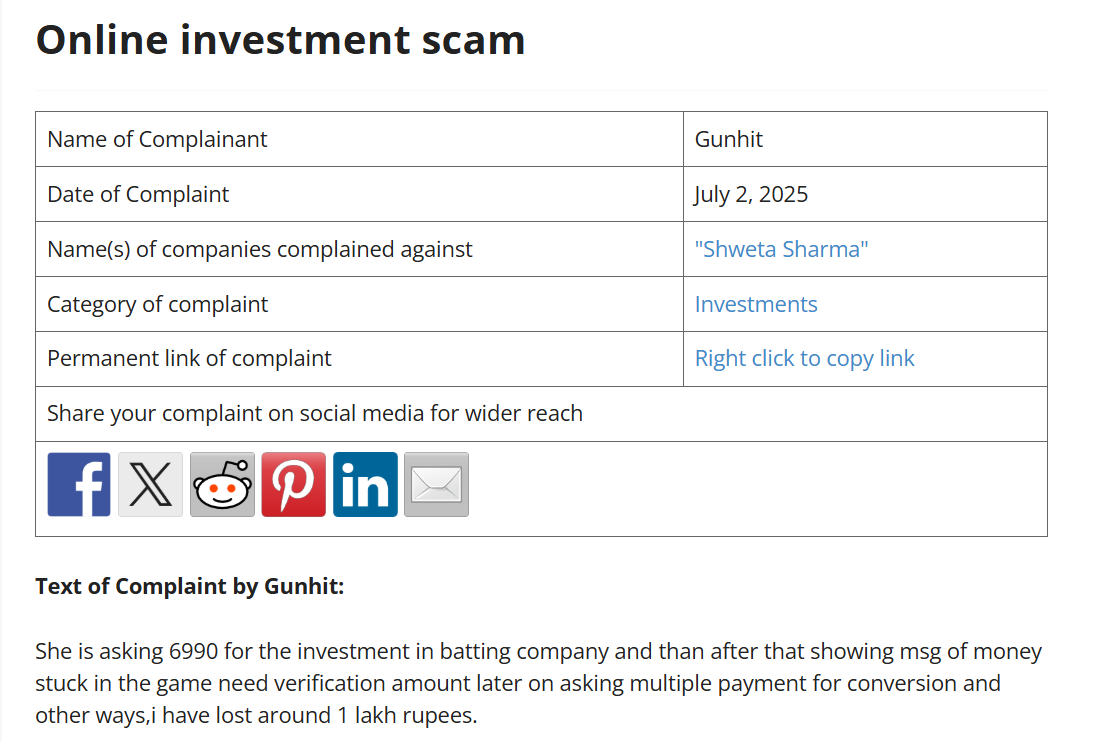
In an age where online scams are becoming increasingly sophisticated, often using deepfakes and impersonation to appear credible, it is essential to approach financial advice with caution. Promises of guaranteed or unusually high returns should immediately raise red flags, especially when tied to upfront payments.
Before investing or transferring funds, individuals must ensure that the advisor or platform is registered with SEBI or affiliated with a recognized financial institution. Conducting proper due diligence is not just advisable - it is necessary. Trust should be placed only in verified sources with proven credentials, as your financial security depends on informed, cautious decisions.
Table 1 - Facebook pages involved in swindling the public
Table 2 - Telegram Channels pages involved in establishing contact
Table 3 - Domains associated with ads on Facebook and Instagram
Table 4 - Instagram pages involved in swindling the public